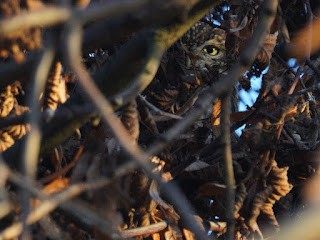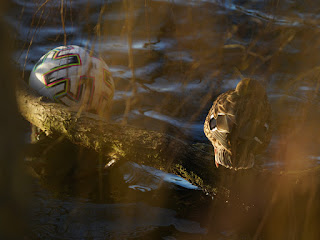Most of the action today was around the rowan trees on Buck Hill. Almost all the fruit is gone from the two large trees, but there are also some saplings that have fruit left. Redwings, a Blackbird and Rose-Ringed Parakeets were feeding here. It's a pity that the parakeets have noticed the rowans at last. They will strip off the fruit in a couple of days, wasting most of it.
Redwings ate fallen fruit under the largest rowan.
There were more in the treetops waiting to come down.
The Mistle Thrush was annoyed by the crowd but couldn't do much about a whole flock.
Also present were a Jay ...
... a Magpie ...
... and three Wood Pigeons having a pause for digestion after gorging on fruit.
The Little Owl just along the path had found a new place to rest among the leaves in the old squirrel drey, but all you could see was one brilliant yellow eye.
Another Wood Pigeon was in the Dell eating the blossom off a mahonia bush.
Two Cormorants at the island had a momentary disagreement.
A Black-Headed Gull and a Coot ate side by side in peace for a few seconds, but the belligerent Coot couldn't resist having a go at the gull.
A Great Crested Grebe fished under the willow near the bridge ...
... through whose branches you could see a female Mallard resting beside a football.
Tufted Ducks were backlit by the low sun.
Greylag Geese find the Diana fountain a good place to drink, wash and preen.
There was a little brown cup-shaped mushroom in the wood chips under the Caucasian Elm in the Rose Garden. I don't think it's some exotic species symbiotic with the foreign elm. It probably came in with the wood chips.
The sun was setting behind the trees as I left.












I seems to me that the days are growing longer visibly by now over there. Is that so?
ReplyDeleteOf course the Coot cannot help being a Coot. By why chase the poor harmless gull so.
I hope there was an army of Mistle Thrushes that would drive parakeets away from the prized rowan fruit. But I guess the fellow is on its own.
Yes, the sun is now setting around 4.10 pm, 20 minutes later than at the winter solstice.
ReplyDeleteThat Mistle Thrush will also drive other Mistle Thrushes away, so he won't recruit an army. Any fruit-eating bird up to and including Jays and Magpies gets attacked. Small birds like Blue Tits and Chaffinches are left alone, although I have seen both eating fruit.
Although sunrise is almost unchanged since the solstice, vagary of earth's motion. Jim
DeleteEverything is wobbly. We are now 91 million miles from the sun. In midsummer we will be 95 million miles away. The universe was not made by Swiss clockmakers.
Delete